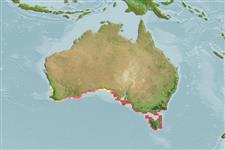Classification / Names
Common names | Synonyms | Catalog of Fishes(genus, species) | ITIS | CoL | WoRMS | Cloffa
Teleostei (teleosts) >
Gobiiformes (Gobies) >
Gobiidae (Gobies) > Gobionellinae
Etymology: Nesogobius: Greek,nessa = island + Latin, gobius = gudgeon (Ref. 45335); maccullochi: Named after A.R. McCulloch, formerly Curator of Fishes at the Australian Museum (Ref. 76773).
More on authors: Hoese & Larson.
Environment: milieu / climate zone / depth range / distribution range
Ecology
Marine; brackish; demersal; depth range 0 - 1 m (Ref. 76773). Subtropical
Distribution
Countries | FAO areas | Ecosystems | Occurrences | Point map | Introductions | Faunafri
Eastern Indian Ocean: Tasmania, Victoria and South Australia
Size / Weight / Age
Maturity: Lm ? range ? - ? cm
Max length : 6.9 cm SL male/unsexed; (Ref. 76773); 6.4 cm SL (female)
Short description
Identification keys | Morphology | Morphometrics
Dorsal spines (total): 7; Dorsal soft rays (total): 5 - 8; Anal spines: 1; Anal soft rays: 7 - 10. This species is distinguished by the following characters: 1st D VI-VIII, usually VII; 2nd D usually I, 8-9; A usually I, 8, branched caudalfin rays usually 10; pectoral fin 17-21, rarely 21; an anterior nasal pore medial to and slightly below level of each anterior nostril and a posterior nasal pore by each posterior nostril, a median anterior interorbital pore between front of eyes, a median posterior interorbital pore between end of eyes, an infraorbital pore behind each eye and a lateral canal pore along dorsal part of operculum, no preopercular pores; wide gill opening extending to below posterior preopercular margin; top of head scaled to behind eyes, in 11-18 rows, from 1st dorsal-fin origin; a small patch of scales near dorsal margin on the operculum and preoperculum (sometimes absent on preoperculum), remainder of head without scales; ctenoid body scales, in 37-49 rows; pectoral base and area before pelvic fin scaled (about 15 rows); 1st dorsal fin with rounded or triangular margin (Ref. 76773).
Found on sandy areas in bays and estuaries, from the intertidal to depths of a few meters (Ref. 76773)
Life cycle and mating behavior
Maturities | Reproduction | Spawnings | Egg(s) | Fecundities | Larvae
Hoese, D.F. and H.K. Larson, 2006. Description of two new species of Nesogobius (Pisces: Gobioidei: Gobiidae) from Southern Australia. Mem. Mus. Victoria 63(1):7-13. (Ref. 76773)
IUCN Red List Status (Ref. 130435)
Human uses
Tools
Special reports
Download XML
Internet sources
Estimates based on models
Preferred temperature (Ref.
123201): 13.4 - 18.1, mean 16.3 °C (based on 141 cells).
Phylogenetic diversity index (Ref.
82804): PD
50 = 0.5625 [Uniqueness, from 0.5 = low to 2.0 = high].
Bayesian length-weight: a=0.01000 (0.00349 - 0.02862), b=3.09 (2.85 - 3.34), in cm total length, based on LWR estimates for this (Sub)family-body shape (Ref.
93245).
Trophic level (Ref.
69278): 3.4 ±0.4 se; based on size and trophs of closest relatives
Resilience (Ref.
120179): High, minimum population doubling time less than 15 months (Preliminary K or Fecundity.).
Fishing Vulnerability (Ref.
59153): Low vulnerability (10 of 100).
